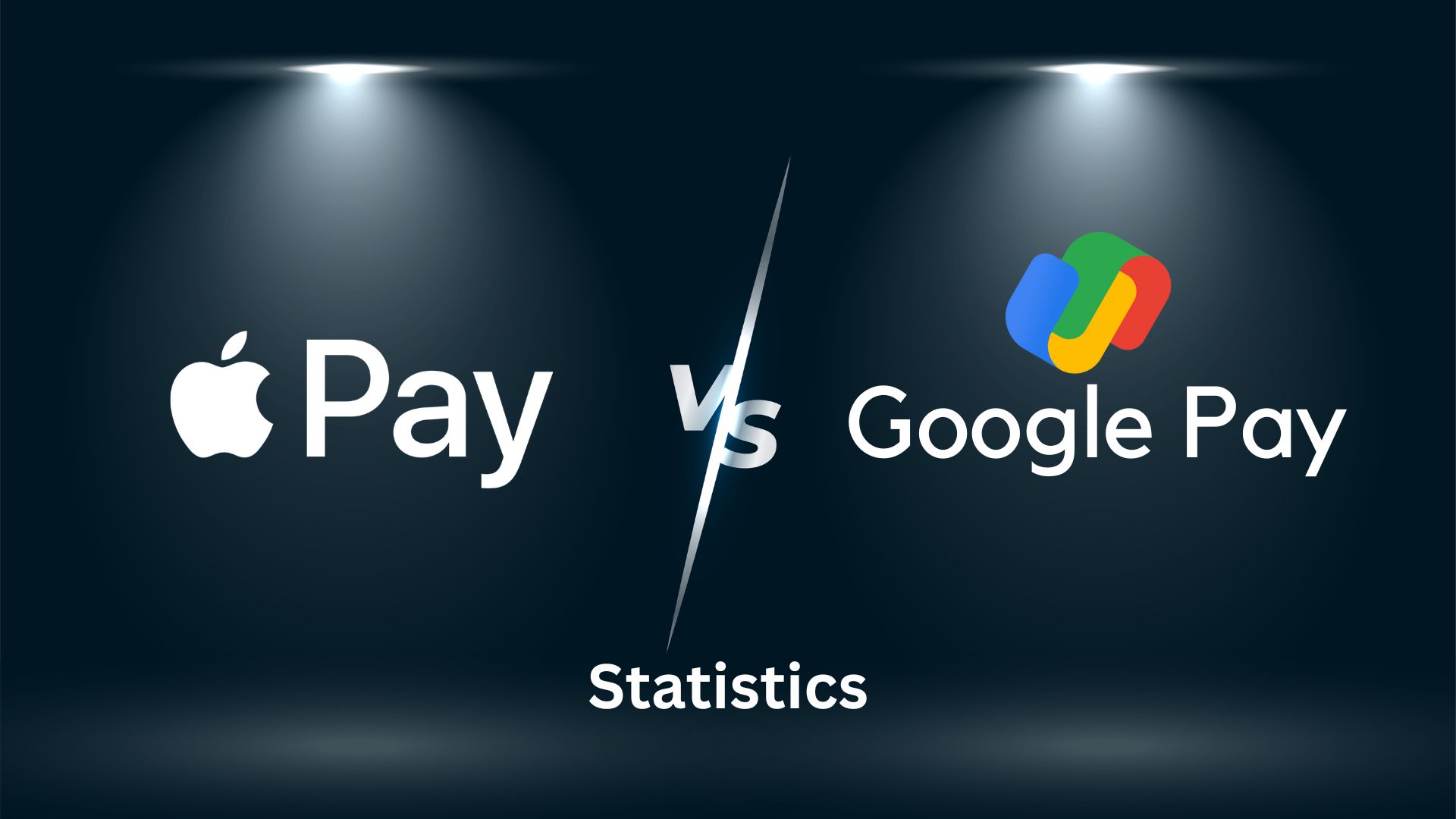Amazon vs eBay Statistics – Which Platform Wins? (2025)
Updated · Sep 11, 2025

Table of Contents
Introduction
Amazon vs eBay Statistics: Amazon and eBay are among the most influential e-commerce platforms worldwide. In 2024, both enjoyed a massive consumer base and billions in revenues. Amazon reigned supreme in raw sales and U.S. share of marketing, with eBay successfully holding the niche as well as the global active users’ corner.
This article offers thorough Amazon vs eBay statistics —revenue, user activity, market presence, and profitability—and paints a clear picture of their comparison in 2025.
Editor’s Choice
- Amazon dominates the U.S. e-commerce market with 37.6% market share, while eBay holds a mere 3% share, showcasing Amazon’s overwhelming market position.
- Amazon’s revenue amounted to US$574.9 billion in 2023, whereas eBay’s was US$10.1 billion, emphasising the realms of difference in the scales of these two platforms.
- Amazon’s global active users surpassed 310 million, while eBay had 132 million active buyers as of Q2 2023, underlining a larger reach for Amazon.
- Amazon made a net income of US$59.2 billion in 2024, more than 20 times higher than eBay’s US$2.77 billion, showing stronger profitability.
- Amazon had a US$362.7 billion U.S. GMV, while eBay managed to only generate US$18.4 billion in global GMV in Q2 of 2024, showing the difference in size of transactions.
- In terms of regional revenue, Amazon’s North American segment earned US$438.02 billion in 2024, while eBay earned US$5.07 billion in the U.S.
- With US$40.86 billion in revenues, Amazon rules Germany while giving only US$971 million to eBay in comparison to its international operations.
- On Japan’s revenue side, Amazon sees US$27.40 billion, while eBay is virtually non-existent, accounting for much of the screaming void in world reach.
- In 2024, Amazon raked in US$37.86 billion in revenue for the UK market, almost entirely eclipsing eBay’s US$1.61 billion, which, again, is indicative of Amazon’s market supremacy.
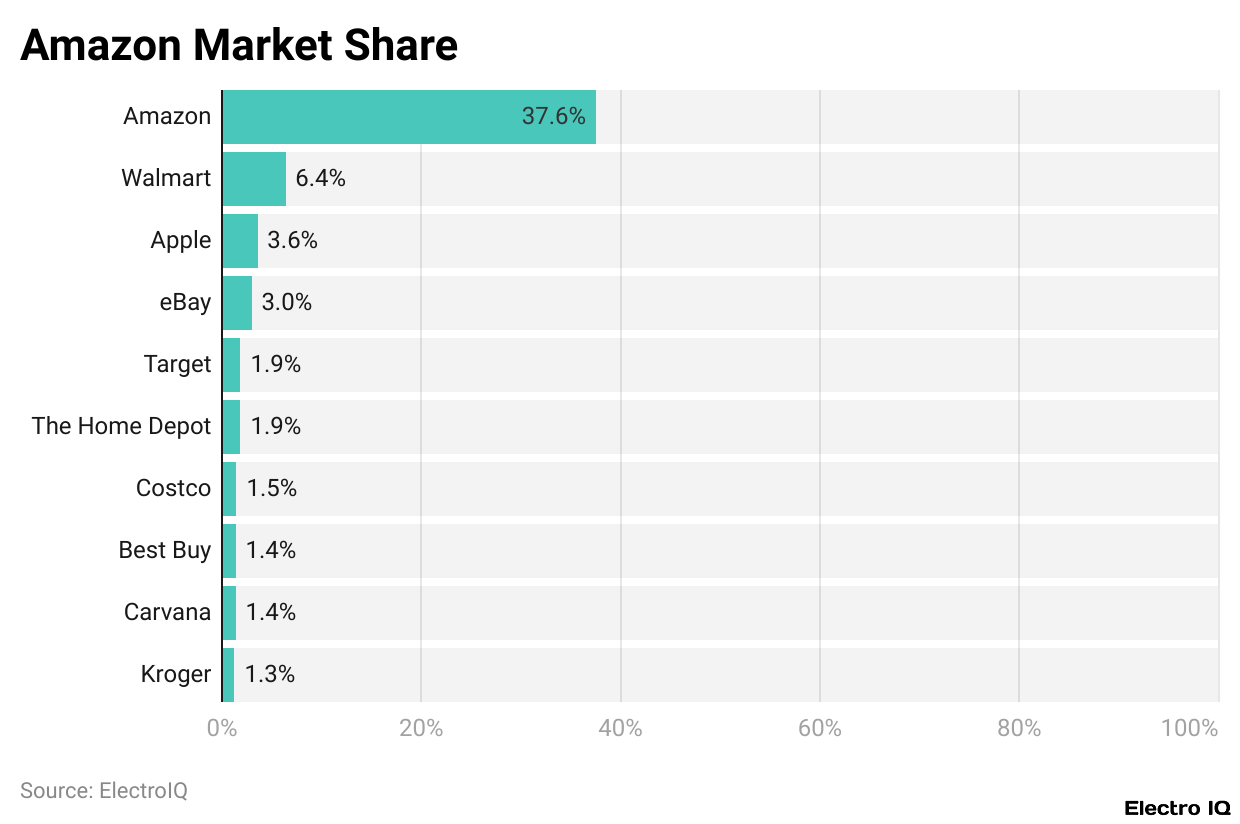
(Reference: demandsage.com)
- In the U.S. e-commerce market, Amazon commands the lion’s share of 37.6%, leaving its nearest competitors far behind.
- Walmart comes at a distant 6.4%, confirming its slowly growing but yet limited online presence in comparison to Amazon.
- Apple would be next with about 3.6%, due to its strong brand and direct sales to consumers. eBay trails Apple by a little, claiming approximately 3%, which is a reflection of its niche appeal in auctions and sales of secondhand goods.
- Target and The Home Depot stand in lockstep with a 1.9% market share each, enjoying similar online sales vitality within their respective industry sectors.
- Costco commands 1.5%, relying upon the patronage of a loyal customer base.
- Best Buy commands 1.4%, as does Carvana, the former online for electronics and the latter for vehicles.
- Kroger completes the list with a share of 1.3%, indicating that its industry sector captures a small slice of the pie of online commerce.
- With numbers such as these, one gets an inkling of Amazon’s blatant dominance and the distributed competition on the part of the rest of the major players.
Revenue
Amazon
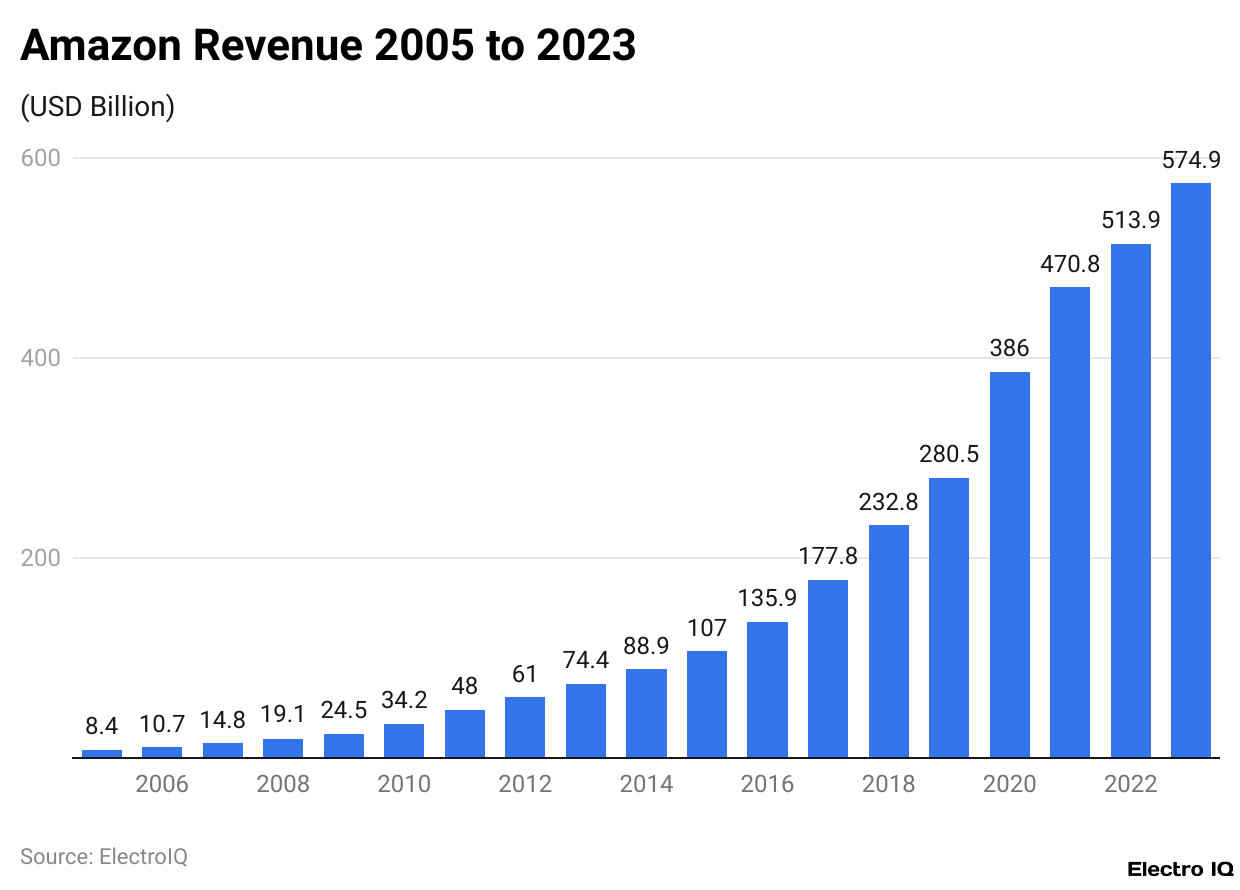
(Reference: coolest-gadgets.com)
eBay

(Reference: statista.com)
- As per a Statista report, Amazon vs eBay statistics show that both are very high in rankings in the global e-commerce environment, but they are very contrasting in terms of scale of operations, growth, and various business models.
- Amazon generated revenues of US$574.9 billion in 2023, marking an 11.9% increase from US$513.9 billion earned in 2022. This trend goes back through 2021 when the revenue stood at US$470.8 billion and further into 2005 when it was just US$8.4 billion.
- Over the span of years, this steady and gigantic increase helped Amazon become ranked third in the world for public companies by revenue, trailing only behind Walmart and China’s State Grid.
- On the other hand, eBay recorded net revenues of US$10.1 billion for the last fiscal year, climbing slightly from US$9.8 billion for the year preceding it.
- While eBay’s revenue is relatively stable, it still amounts to only a tiny fraction of what Amazon bills, showing there’s an exodus in scale.
- eBay remains one of the oldest online marketplaces, operating in a little over 30 countries. It established the auction style of e-commerce and later expanded to fixed-price formats and local classified ads.
- eBay typically facilitates C2C- and small business-type sales rather than acting as a direct retailer like Amazon. 132 million active buyers existed on the eBay platform as of 2023 Q2, which is to be contrasted with Amazon’s purported 310+ million active users.
- eBay has a special forte when it is mobile, its app standing alongside the best consumer-to-consumer platforms, competing against Amazon and big brick-and-mortar names like Walmart.
- Historically, one important note is that at one point, eBay owned PayPal, whose revenues constituted a huge portion of eBay until the companies split in 2015. Since the split, revenue for eBay has remained relatively cushioned against decline, while Amazon has been aggressively diversifying through cloud services (AWS), logistics, and advertising and subscription services.
- eBay was not able to keep track of the revenue list from the other major internet companies. While Amazon offers enhanced level services, exponential revenue opportunities, and aggressive growth patterns, eBay sustains dominance as a client-to-client and niche marketplace, having garnered the loyalty of all those clients and a strong mobile application.
Amazon vs eBay Generations
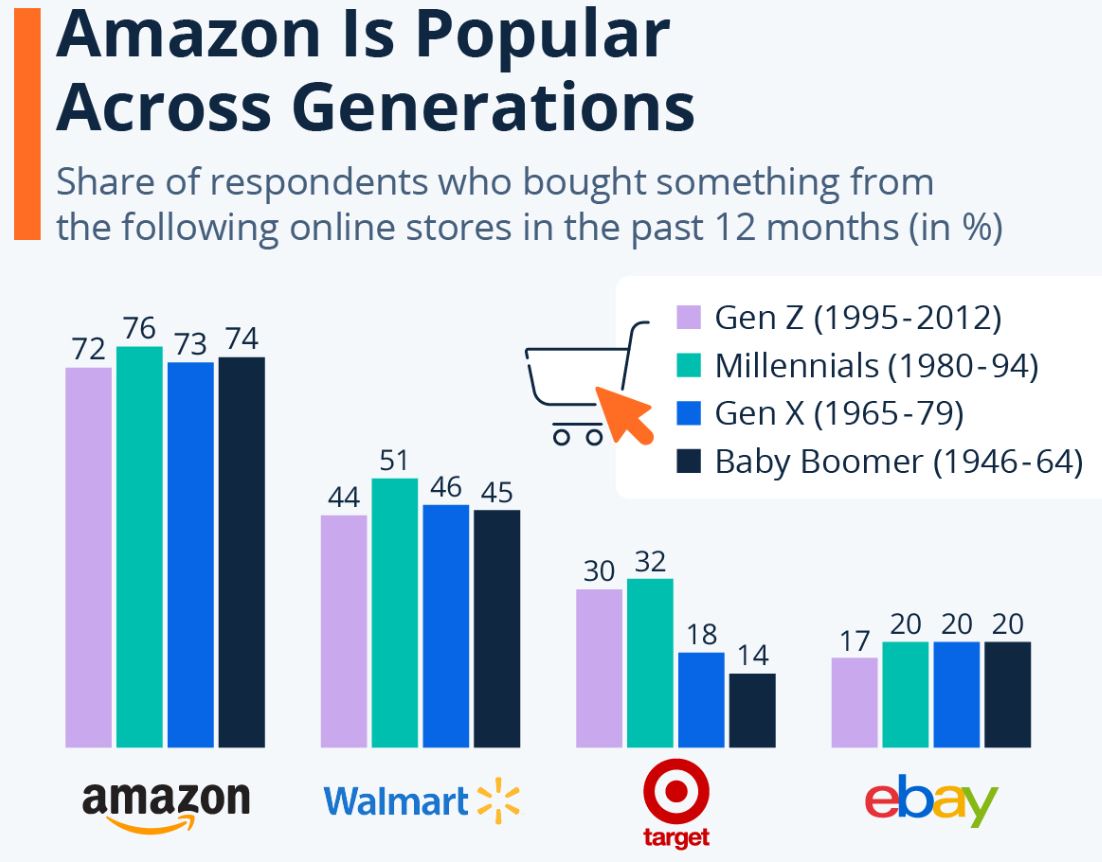
(Reference: statista.com)
- The first half of 2024 saw a 38% revenue realisation from direct sales by Amazon, while 24% more came from the third-party sellers using the Amazon platform. Amazon is a clear leader in the United States e-commerce sector, particularly if consumer behaviours are to be analysed.
- According to a recent study by Statista Consumer Insights, some 72% to 76% of people from all age groups—from Gen Z through Baby Boomers—had purchased something from Amazon during the last 12 months.
- Walmart was far behind, with only about 44% to 51% of people from those very age groups having said they bought items from that retailer.
- Beyond Amazon and Walmart, looking at generational preferences starts to get a little more diverse.
- A favourite third store among youngsters, Generation Z and Millennials, but with Generation X and Baby Boomers, eBay stands as more of a stronghold, with 20% of each of these groups having purchased from the firm in the past year.
- International competitor AliExpress, a part of China’s Alibaba Group, is much less engaging in the U.S. Only 1% of the Baby Boomers and 6% of those born between 1956 and 1979 had utilised the platform.
- The interest was a tad higher for younger demographics, with 17% of those aged 30 to 44 and 11% of users under 30 having purchased off the platform within the same timeframe.
- These numbers underscore the strong, tight, and consistent grip Amazon maintains over the U.S. market, along with the generational variations observed in the latter platform choices.
Amazon vs eBay Net Income
Amazon
| Amazon Annual Net Income (Millions of US $) |
|
| 2024 | $59,248 |
| 2023 | $30,425 |
| 2022 | -$2,722 |
| 2021 | $33,364 |
| 2020 | $21,331 |
| 2019 | $11,588 |
| 2018 | $10,073 |
| 2017 | $3,033 |
| 2016 | $2,371 |
| 2015 | $596 |
| 2014 | -$241 |
| 2013 | $274 |
| 2012 | -$39 |
(Source: macrotrends.net)
eBay

(Reference: 3dsellers.com)
- As per Microtrends and 3dsellers, Amazon vs eBay statistics show that the annual net income averages tell very contrasting stories for Amazon and eBay, underscoring the differences in scale and financial trajectory between the two.
- The end-of-year result of the big year came for Amazon in 2024 at a hefty level of net income of US$59.2 billion. This amount nearly doubled the previous year’s record-high earnings of just US$30.4 billion in 2023. The rebound is doubly worthy of note given the 2022 loss of US$2.7 billion.
- Showing generally upward trends over time, Amazon netted US$34.2 billion in 2021 and US$21.3 billion in 2020.
- The ebbs and flows of eBay are much smaller compared to Amazon. In this year of 2023, eBay put up US$2.77 billion in net income after recovering from a US$1.27 billion loss in 2022.
- It had its best year in 2021 with a massive US$13.6 billion profit, thanks primarily to the one-time gains from selling assets like the classified ads business.
- eBay made US$5.67 billion and US$1.79 billion in 2020 and 2019, respectively, signifying solid returns during that period.
- Speaking on a very long-term note, however, eBay’s profitability has varied; among its highs: US$7.27 billion in 2016; among its lows: US$1.02 billion in 2017 and smaller negatives in earlier years.
- Amazon’s net income has more recently dwarfed eBay’s, especially since 2021.
- Both companies have had volatile years, but the ability of Amazon to generate massive profits in recent times is a testament to the strength and scale of its diversified business model.
- The narrower operational scope of eBay has inflicted financial instability upon the company for many years. Earnings have hence eroded to a mere fraction of Amazon’s.
Amazon vs eBay GMV
Amazon
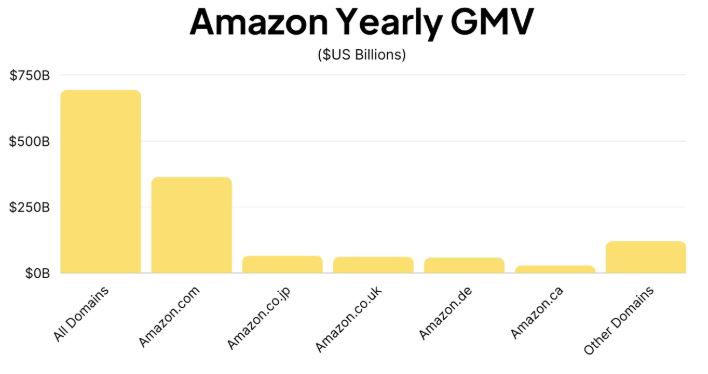
(Source: mobiloud.com)
eBay
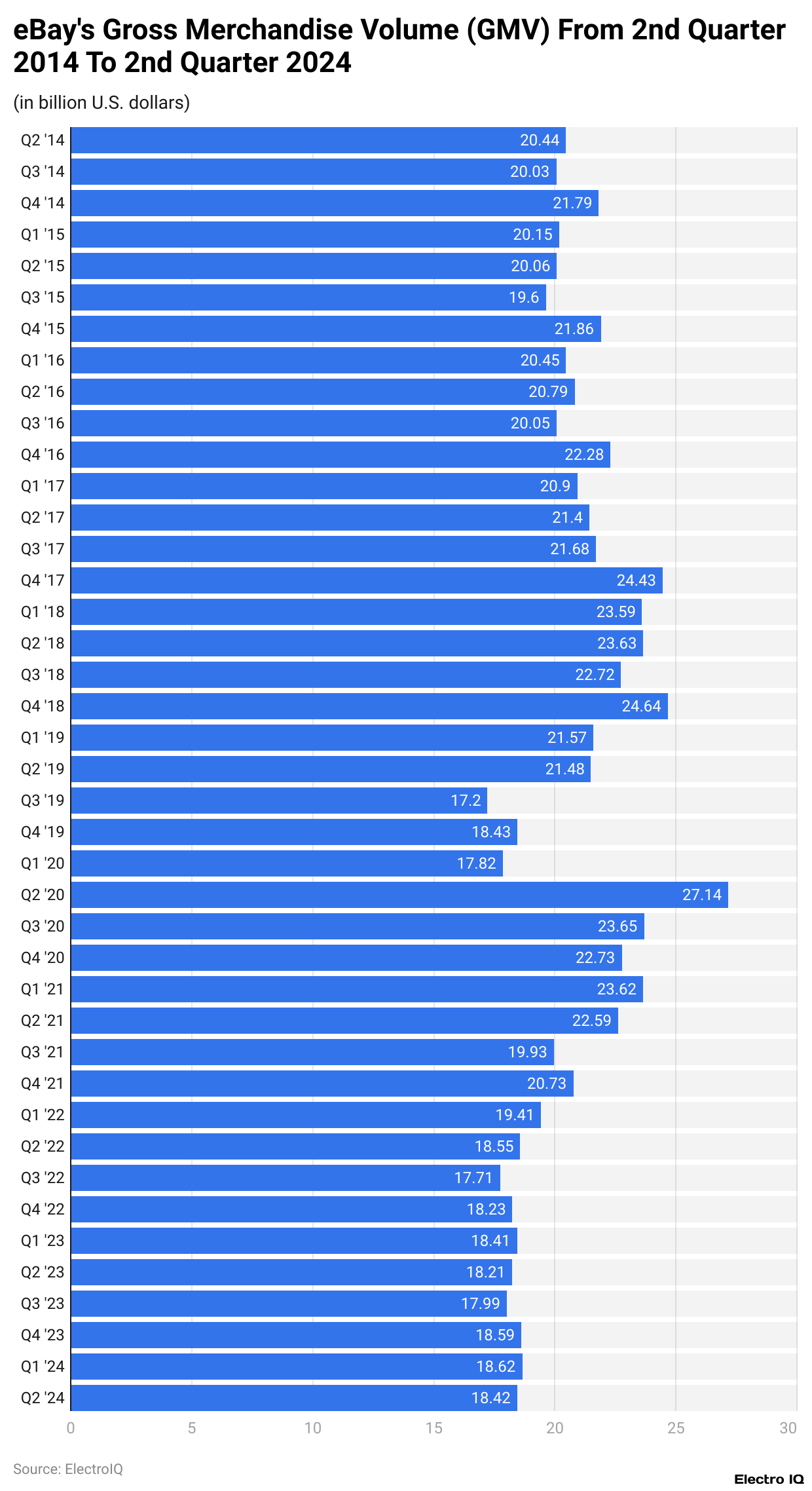
(Reference: statista.com)
- According to Staista and Mobiloud, Amazon vs eBay statistics reveal that globally, Amazon product sales hit close to US$700 billion annually, with the largest chunk coming from U.S. sales alone: US$362.7 billion, topping 52.35% of total gross merchandise volume (GMV).
- Japan, on the other hand, stands as the second-largest market for Amazon, bringing in about US$64.9 billion GMV, or roughly 9.37% of the global total.
- By contrast, eBay’s GMV amounts to a small figure. In Q2 2024, eBay posted a GMV of around US$18.4 billion, marking a slight dip from the preceding quarter.
- Amassed at more than US$27 billion at its peak in the early months of the COVID pandemic—the period of April to June 2020—this was the highest GMV eBay ever experienced.
- The record achievement aside, it falls far short of Amazon’s current quarterly and single-country GMV, establishing the glaring difference in scale and reach between the two platforms.
Amazon vs eBay Revenue By Region
Amazon

(Reference: bullfincher.io)
eBay

(Reference: coolest-gadgets.com)
- As per Statista and Bullfincher, Amazon vs eBay statistics state that backing up that soaring number is North America, dominating all other regions with US$438.02 billion in revenue, representing 68.66% of eBay’s total. This dominance eclipses the successes in all other regions.
- On the other hand, U.S. operations for eBay brought in US$5.07 billion in 2023, a tiny fraction of what Amazon earned in North America but its largest-hitting region.
- Germany took the next place after North America, by contributing US$40.86 billion or 6.4% of total revenue for Amazon.
- eBay also worked in Germany; however, the revenues were much smaller, about US$971 million in 2023. That speaks volumes about the size difference between the two in the same geography.
- The International Segment (i.e., all other regions not reported separately) came through with revenues of US$93.83 billion or 14.71% of total revenues, the equivalent of more than six times eBay’s total international revenues, which stood at US$1.43 billion beyond its top three markets.
- In Japan, Amazon derived US$27.40 billion in revenues, or 4.3% of its total revenues, making it the smallest named market for Amazon.
- eBay does not separately report revenue for Japan, signifying a less-established or limited presence there, and a less strategic presence at that.
- Amazon UK generated US$37.86 billion, or roughly 5.93%, of its total revenue in 2024, while eBay posted revenue of US$1.61 billion in 2023.
- Hence, for the UK alone, Amazon’s revenues were more than 23 times those of eBay, pointing to a wider customer base and offerings for Amazon.
- Globally and within the reported regions, in terms of both absolute dollars and market share, Amazon reigns largely supreme over eBay, purely by its extensive global infrastructure and diversified revenue streams.
Conclusion
Amazon vs eBay statistics: Both Amazon and eBay found their unique niches in 2024. Amazon dominates with sheer size, revenue, and strategic diversification of services, further cementing its position as a front-runner in e-commerce worldwide. eBay, on the other hand, remains a solid performer, sustained by gross profitability, a loyal user base, and a marketplace model geared toward auctions and one-of-a-kind offerings.
Together, these two platforms embody the duality of modern e-commerce: one striding forward through mass reach and integration, and the other catering to the intricate dynamics of specialised buyer-seller relationships.
Sources
FAQ.
Amazon owns a commanding 37.6% share of the U.S. e-commerce market, far eclipsing the 3% share of eBay. This makes Amazon a major player while eBay has become a niche player known for auctions and selling second-hand goods.
Amazon generated revenues of US$574.9 billion in 2023, compared to eBay’s US$10.1 billion, which makes the difference more than 56 times. Its growth is spurred by multiple segments, including retail, cloud services (such as AWS), and advertising, whereas eBay’s revenue is primarily derived from its core marketplace.
Amazon had 310 million active users worldwide, compared with eBay’s 132 million active buyers in the second quarter of 2023. This underscores Amazon’s broader global footprint and more robust user engagement.
In the year 2024, Amazon made a net income of 59.2 billion, while eBay’s was just 2.77 billion. That means Amazon is some 20 times more profitable, and this is driven by scale and diversified revenues.
Amazon recorded a US$362.7 billion U.S. GMV in 2022, which perhaps nudged the global GMV close to US$700 billion. Comparatively, eBay recorded a US$18.4 billion global GMV for Q2 2024, indicating an enormous difference in transaction volumes.

Maitrayee Dey has a background in Electrical Engineering and has worked in various technical roles before transitioning to writing. Specializing in technology and Artificial Intelligence, she has served as an Academic Research Analyst and Freelance Writer, particularly focusing on education and healthcare in Australia. Maitrayee's lifelong passions for writing and painting led her to pursue a full-time writing career. She is also the creator of a cooking YouTube channel, where she shares her culinary adventures. At Smartphone Thoughts, Maitrayee brings her expertise in technology to provide in-depth smartphone reviews and app-related statistics, making complex topics easy to understand for all readers.






